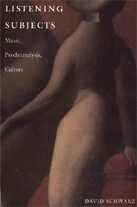
p
Listening Subjects: Music, Psychoanalysis, Culture (Duke University Press 1997).
I have been fascinated for some time by the goose bumps I sometimes get while listening to music. What exactly is happening when they occur? How important is familiarity with the music or lack of familiarity to the experience? Are goose bumps universal? Is the experience contingent on a cultural context? Is there something in our childhood or infancy that makes the experience possible? Why are goose bumps so powerfully at the skin--the boundary separating our bodies from the rest of the world? How can classical and popular music, even music I would call sentimental trash, give me goose bumps?
The chapters of Listening Subjects probe questions like the ones above. "Music as Sonorous Envelope and Acoustic Mirror" asks why music often sounds so good when heard all around; take for example, John Adams' Nixon in China. Scatting, the Acoustic Mirror, and the Real in The Beatles, "I Want You"; began with the question how the white noise at the end of the song can mean anything. "Why Notes Always Reach Their Destination (at Least Once) in Schubert's Winterreise" asks how music can represent a crisis of conventional subjectivity; take "Der Leiermann", for example. "Music and the Gaze: Schubert's "Ihr Bild"; and "Der Doppelgaenger"; interrogates the nature of musical doubles. "Peter Gabriel's 'Intruder,' a Cover, and the Gaze" examines structures within which a male listener can relate to the song's representation of a violent sexual fantasy. "Oi: Music, Politics, and Violence" asks about the musical, textual, and ideological structure of German postrock Oi-Musik, as in Stoerkraft, "Terror" and Stoerkraft, "Mann fuer Mann"."Lamentation, Abjection, and the Music of Diamanda Galás" explores how music can produce terror and awe, displeasure and pleasure at the same time, as in Diamanda Galá: Plague Mass.
These are some of the personal questions that got Listening Subjects started. Addressing these questions involved engaging scholarship in new musicology, psychoanalysis, music theory, and history. I would like this book to participate in a growing body of criticism that brings these fields together as equal partners. For several decades, the work of Slavoj Žižek has influenced film studies, literary studies, and cultual studies, drawing together Lacanian psychoanalysis, Marxism, history, and popular culture. Listening Subjects introduces his techniques into music studies. Why psychoanalysis? In part, I am drawn to psychoanalysis temperamentally; music of it just seems right, particularly with daily confirmations from the experiences of raising a small child.
But I also feel that it is only through the psychoanalytic techniques outlined in this book that one can get into a nuanced discourse of music as visceral experience to explain what happens to listeners of music. Psychoanalytic criticism can also ground a wide variety of textual claims in social space. Throughout Listening Subjects, I implicitly or explicitly discuss music as cultural artifact. For example, two of the chapters of this book address music by Franz Schubert from a psychoanalytic point of view. For me and many music scholars, much nineteenth-century classical music is about alterity; the formal and harmonic experiments of Beethoven, the song cycles of Schubert, the song-like piano works of Chopin and Schumann, the exquisite temporal complexities of Wagner, and music as re-writing in Liszt. Historically, the nineteenth century opens the space of modernism, and its music explores the epistemological doubt of the era.
For me, listening is the process of unpacking the musical-theoretical, musical-historical, cultural, psychoanalytic, and personal dimensions of music. Throughout the book (particularly in the initial chapters), I discuss two registers of listening--as a fantasy thing and as fantasy space. Listening as a fantasy thing is produced when attributes of a structure represented in music are described and related to one another. Listening as fantasy space is produced when musical-theoretical, musical-historical, cultural, psychoanalytic, or personal thresholds are crossed and enunciated. Both listening thing and listening space are always retrospective fantasies since we have direct access to neither events that structured our developing subjectivity nor historical contexts as immanent experiences of reality. These experiences and contexts have left traces, however, in how we listen to music.
For me, listening things and listening spaces are unevenly and indistinctly marked at their boundaries since music theory, music history, culture, psychoanalysis, and personal experiences occupy different logical classes. For example, if I analyzed the pitch structure of the "Star-Spangled Banner" as a composing out of the overtone series in a particular key, then I would produce a fantasy of a listening thing--not necessarily stable, but treated for a moment from a certain perspective as if the relation between the overtone series and the pitch structure of the song were objectively "there" on a page, in the music, in our ears. Interrogating the ideological structure of the natural status of the overtone series would turn the fantasy thing into a fantasy space--a threshold between pitch-structure, form, and musical lnaguage on the one hand, and a historical context that makes pitch structure, form, and musical language possible, on the other. These two critical gestures occupy different registers: a fantasy thing can be formalistic, a "whole" that is heirarchical, subordinate, transhistorical; a fantasy space can be heterogeneous, fragmented, coordinated, culturally and personally specific.
There can be no single point of entry into the things and spaces of listening; no diachronic trajectory will take us across them. The chapters of this book are thus not like the terraced structures of traditional hermenuetic rhetoric. Each chapter unpacks itw own interrogation of listening things and spaces, beginning with chapters that emphasize the psychoanalytic and ending with chapters that emphasize the cultural conditions that make music as listening possible.



